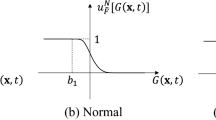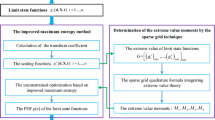Abstract
Aiming at efficiently estimating the dynamic failure probability with multiple temporal and spatial parameters and analyzing the global reliability sensitivity of the dynamic problem, a method is presented on the moment estimation of the extreme value of the dynamic limit state function. Firstly, two strategies are proposed to estimate the dynamic failure probability. One strategy is combining sparse grid technique for the extreme value moments with the fourth-moment method for the dynamic failure probability. Another is combining dimensional reduction method for fractional extreme value moments and the maximum entropy for dynamic failure probability. In the proposed two strategies, the key step is how to determine the temporal and spatial parameters where the dynamic limit state function takes their minimum value. This issue is efficiently addressed by solving the differential equations satisfying the extreme value condition. Secondly, three-point estimation is used to evaluate the global dynamic reliability sensitivity by combining with the dynamic failure probability method. The significance and the effectiveness of the proposed methods for estimating the temporal and spatial multi-parameter dynamic reliability and global sensitivity indices are demonstrated with several examples.




Similar content being viewed by others
References
Andrieu-Renaud C, Sudret B, Lemaire M (2004) The PHI2 method: a way to compute time-variant reliability. Reliab Eng Syst Saf 84(1):75–86
Au SK, Beck JL (2003) Important sampling in high dimensions. Struct Saf 25(2):139–163
Belisle CJP (1992) Convergence theorems for a class of simulated annealing algorithm on Rd. J Appl Probab 29(4):885–895
Binder K (1997) Applications of the Monte Carlo method to statistical physics. Rep Prog Phys 60(5):487–559
Borgonovo E (2007) A new uncertainty importance measure. Reliab Eng Syst Saf 92(6):771–784
Brandimarte P (2004) Finite-difference methods for partial differential equations. Dover Publications, Inc
Cui LJ, Lu ZZ (2010) Moment-independent importance measure of basic random variable and its probability density evolution. Sci China Technol Sci 53(4):1138–1145
Du X (2014) Time-dependent mechanism reliability analysis with envelope functions and first-order approximation. J Mech Des 136(136):52–68
Hasofer AM, Lind NC (1974) An exact and invariant first order reliability format. J Eng Mech 100:111–121
He J, Gao S, Gong J (2014) A sparse grid stochastic collocation method for structural reliability analysis. Struct Saf 51:29–34
Hu Z, Du XP (2013) Time-dependent reliability analysis with joint upcrossing rates. Struct Multidiscip Optim 48(5):893–907
Inverardi PL, Tagliani A (2003) Maximum entropy density estimation from fractional moments. Commun Stat Theor Method 2(2):327–345
Jiang C, Huang XP, Wei XP (2014) A time-variant reliability analysis method for structural systems based on stochastic process discretization. J Mech Des 136(9):1–21
Kang Z, Luo YJ (2009) Non-probabilistic reliability-based topology optimization of geometrically nonlinear structures using convex models. Comput Methods Appl Mech Eng 198:3228–3238
Kang Z, Luo YJ (2010) Reliability-based structural optimization with probability and convex set hybrid models. Struct Multidiscip Optim 42:89–102
Li G, Artamonov M (2003) High-dimensional model representations generated from low order terms-IP-RS-HDMR. J Comput Chem 24(5):647–656
Li J, Mourelatos ZP (2009) Time-dependent reliability estimation for dynamic problems using a niching genetic algorithm. J Mech Des 131(7):1119–1133
Li L, Lu Z, Feng J (2012) Moment-independent importance measure of basic variable and its state-dependent parameter solution. Struct Saf 38(38):40–47
Lutes LD, Sarkani S (2004) Random vibrations: analysis of structural and mechanical systems. Eur J Cardiothorac Surg 22(4): p 656
Lutes LD, Sarkani S (2009) Reliability analysis of system subject to first-passage failure. NASA Technical Report no. NASA/CR-2009-215782
Malhotra R, Singh N, Singh Y (2011) Genetic algorithms: concepts, design for optimization of process controllers. Comput Inf Sci 4(2):39–54
Moore RE (1966) Interval analysis. Prentice Hall, Englewood Cliffs, NJ
Mourelatos ZP, Majcher M, Pandey V (2015) Time-dependent reliability analysis using the total probability theorem. J Mech Design 137(3): V02BT03A052
Rabitz H (1999) General foundations of high-dimensional model representations. J Math Chem 25(2):197–233
Rice SO (2015) Mathematical analysis of random noise. Bell Syst Tech J 24(1):46–156
Rosenblatt M (1952) Remarks on a multivariate transformation. Ann Math Stat 23(3):470–472
Schueller GI, Pradlwarter HJ, Koutsourelakis PS (2004) A critical appraisal of reliability estimation procedure for high dimensions. Probab Eng Mech 19(4):463–474
Singh A, Mourelatos ZP, Li J (2010) Design for lifecycle cost using time-dependent reliability. J Mech Des Trans ASME 132(9):0910081–09100811
Smolyak SA (1963) Quadrature and interpolation formulae on tensor products of certain function classes. Dokl Akad Nauk SSSR 4(5):240–243
Sobol IM (2001) Global sensitivity indices for nonlinear mathematical models and their Monte-Carlo estimates. Math Comput Simul 55(1-3):271–280
Song J, Lu Z, Wei P (2015) Global sensitivity analysis for model with random inputs characterized by probability-box. Proc Inst Mech Eng Part O-J Risk and Reliab 229(3):237–253
Sudret B (2008) Analytical derivation of the outcrossing rate in time-dependent reliability problems. Struct Infrastruct Eng 4(5):353–362
Sudret B, Der Kiureghian A (2000) Stochastic finite element methods and reliability: a state-of-the-art report. Department of Civil and Environmental Engineering, University of California, Berkeley
Tan XH, Liu XR (2006) Study on solution of limit state function’s gradients in reliability analysis. Rock Soil Mech
Wei PF, Lu ZZ (2012) Efficient sampling methods for global reliability sensitivity analysis. Comput Phys Commun 183(8):1728–1743
Zadeh LA (1978) Fuzzy sets as a basis for a theory of possibility. Fuzzy Sets Syst 1(1):3–28
Zhang LG, Lu Z, Chen J (2014a) An efficient method for failure probability-based moment-independent importance measure. Acta Aeronaut Astronaut Sin 35(8):2199–2206
Zhang L, Lu Z, Cheng L (2014b) A new method for evaluating Borgonovo moment-independent importance measure with its application in an aircraft structure. Reliab Eng Syst Saf 132(8):163–175
Zhang X, Pandey MD (2013) Structural reliability analysis based on the concepts of entropy, fractional moment and dimensional reduction method. Struct Saf 43(9):28–40
Zhang X, Pandey MD, Zhang Y (2014c) Computationally efficient reliability analysis of mechanisms based on a multiplicative dimensional reduction method. J Mech Des 136(6):682–694
Zhao YG, Ono T (1999) A general procedure for first/second-order reliability method (FORM/SORM). Struct Saf 21(2):95–112
Zhao Y, Lu Z (2007) Applicable range of the fourth-moment method for structural reliability. J Asian Archit Build Eng 6(1):151–158
Acknowledgements
This work was supported by the Natural Science Foundation of China (Grant 51475370) and the fundamental research funds for the central university (Grant 3102015 BJ (II) CG009).
Author information
Authors and Affiliations
Corresponding author
Rights and permissions
About this article
Cite this article
Shi, Y., Lu, Z., Cheng, K. et al. Temporal and spatial multi-parameter dynamic reliability and global reliability sensitivity analysis based on the extreme value moments. Struct Multidisc Optim 56, 117–129 (2017). https://doi.org/10.1007/s00158-017-1651-2
Received:
Revised:
Accepted:
Published:
Issue Date:
DOI: https://doi.org/10.1007/s00158-017-1651-2




